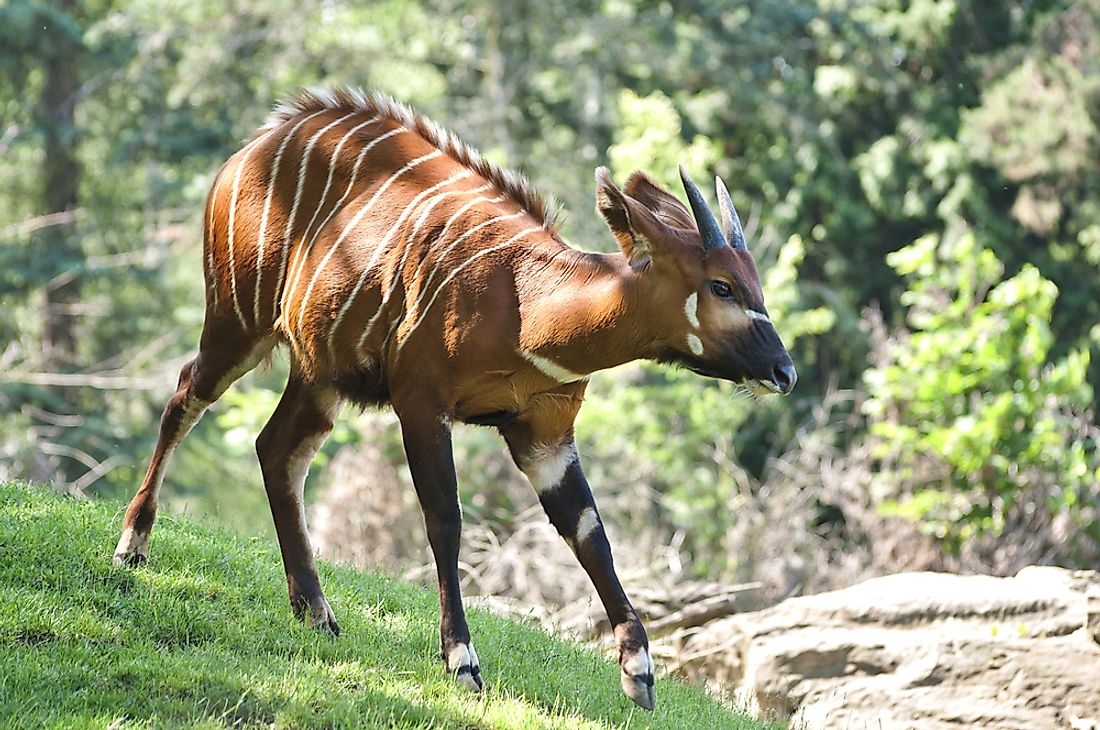Bongo Facts: Animals of Africa

The Bongo (Tragelaphus eurycerus) is the largest antelope species inhabiting the forests of Western and Eastern Africa. There are two major populations of the bongo: western (lowland) and eastern (mountain) bongo. The lowland bongo inhabits the dense lowland forests of Western and Central Africa while the mountain bongo inhabits the highland Aberdare forest of central Kenya where they live under protection. In their natural habitat, bongos can survive up to 18 years.
Appearance
Bongos are the largest forest antelopes and are identified by their deep chestnut color with bright white stripes on either side for camouflage. An adult measures up to 10.3 feet and can weigh up to 893 pounds. They have a distinctive white chevron between their eyes, white colorations on their cheeks, and a white arced shape on the chest. Bongos have large elongated ears that allow them to detect predators and a long prehensile tongue adapted to grasping grass, roots, and leaves with ease. They also have distinctively spiraled horns with those of males being longer and darker as compared to their female counterparts.
Diet
Bongos are selective browsers and mainly feed on leaves, roots, fruits, barks, and grass. They are mainly nocturnal and forage in the cover of darkness to avoid contact with predators. They have a four-chambered ruminating stomach that aids in the breakdown of plant cellulose. The digestion process is slow in bongos in comparison to other mammals to help maximize their nutritional intake.
Behavior
Bongos are shy elusive creatures and are rarely seen. Similar to other antelope species, bongos flee with their horns laid back and pressed against their body when they feel threatened. Male bongos are solitary and only interact with other bongos during the mating season. Female bongos are social and predominantly live in herds consisting of 50 members including their calves. They communicate through grunts, moos, snuffles, and bleats when in distress or in the event of impeding danger.
Reproduction
Breeding occurs between October and January after which the females give birth to a single calf following a nine months gestation period. To protect the vulnerable newborn calf from predators, females give birth in secluded thickets where the calf lies silently for about a week. During this time, the mother returns to the herd but returns regularly to nurse her calf. When the calf is strong, they return to the herd for additional protection and remains with the herd until they reach sexual maturity at 2 years.
Conservation Status
The western bongo is classified as a near threatened species while the eastern bongo is critically endangered. Although the mountain bongo has always been rare, there are only 100 individuals left in highlands of Kenyan forests where they live under protection. The natural habitats of the bongo have been threatened by human activity mainly logging and deforestation leading to the drastic decline in their numbers. In their natural habitats, bongo’s are hunted for game meat and horns. They are also highly susceptible to tropical diseases that nearly wiped out the entire population in the early 19th century. Conservation efforts have been undertaken including captive breeding to prevent the animal from becoming extinct.











